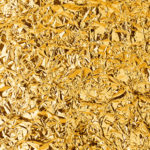During the Middle Ages, alchemists pursued the impossible by trying to convert ordinary lead into precious gold. History showcases these alchemists as being wacky and delusional, but they were only a few centuries too early. Today, we can produce gold using modern technology.
To understand how gold became so crucial in our society, we need to look at from where it comes. So grab a telescope because our story begins in the vast expanse of outer space.
The Extraterrestrial Element
Unlike other metals that form in the Earth’s crust, gold comes from space. Stars are made mostly of helium and hydrogen, which provide light. Inside the star’s core, nuclear fusion churns out energy. As the star’s life comes to an end, a massive stellar explosion occurs known as a supernova.
The pressure of a collapsing star is so intense that it forces protons and electrons to create a neutron. Since neutrons don’t have any repelling electric charge, they’re easily swallowed up by heavier elements such as iron. As the iron gathers more neutrons, heavier elements form.
But how did all this space gold end up in our home? Planets form from a swell of gas and dust cast out through space via a supernova. The gold particles were likely mixed up in the cosmic cloud that formed Earth.
Fast forward a few billion years, and we now mine this precious metal to make jewelry, computer chips, false teeth, and more.
Where Is Gold Found on Earth?
All of the gold formed in the stars sank to the Earth’s core. Eventually, asteroids struck the Earth, causing gold to surface to the mantle and crust. Had this not happened, there wouldn’t be any gold readily available for humans.
You can find gold today in rock ores and on almost all the continents. Since gold is dense, the majority of it sank to the bottom of the ocean. Studies suspect that there are around 20 million pounds of gold in the sea.
Earthquakes also help gold deposits form. As the faults shift, mineral-rich water decompresses. Once the water vaporizes, you’ll find strips of gold and quartz resting on rocky surfaces. Similar activity happens in volcanoes.
South Africa and India have the two largest known gold deposits. Johannesburg rests on top of a gold deposit. India’s Kolar region is rich with precious metals, and Indians consume the most gold products out of any other country.
How Much Gold Exists on Earth?
The World Gold Council states that around 190,040 metric tons of gold have been mined throughout history. All that gold is worth around $7.5 trillion, and about 85% of it is still in circulation. Since gold is so dense, 190,040 metric tons would only fill around 4 Olympic swimming pools.
There’s still roughly 1 million tons of gold in the outer layer of the Earth’s crust. It’s unknown how much is in the mantle and core, but it’s assumed to be much more than the crust amount.
Why Do We Love Gold?

Throughout history, gold has had robust control over our society. It’s long-lasting beauty, and adaptable nature makes it one of the most sought after elements on the planet. The Aztecs considered gold to be the excrement of the gods. But with modern technology and resources, why do we still go crazy for this expensive product?
For starters, gold is scarce. Other metals like silver and copper don’t come close in terms of scarcity. Therefore, gold is far more valuable. Also, gold has unique properties that other metals lack. It doesn’t tarnish, and it’s exceptionally malleable. You can pound a single ounce of gold into a 100 square foot sheet.
Let’s face it, gold is eye-catching, and we love to flaunt it. That’s why most jewelry contains a fair amount of gold. Kings and queens across the globe have used the precious metal to display their divine superiority.
Up until the early 1960s, most western economies used the gold standard—a fixed amount of gold which backed the value of a country’s currency. The United States still has around 147.3 million ounces of gold stockpiled in Fort Knox.
Other than being used to display wealth or as a fashion statement, gold has some fantastic practical uses. Probably its most important use is as a conductor for electricity. Its anti-corrosion properties make it a great resource to power our computers and mobile devices.
How Do We Use Gold in the Modern World?
As mentioned above, gold is a highly-malleable element. Here are some ways we use gold in modern society.
Wealth & Finance
Because of its rarity, people consider gold a valuable asset. It’s portable, easy to distinguish, and simple to divide—many of the new paper currencies used to be backed by gold. In the United States, people could trade in paper money in exchange for an amount of gold equal in value.
Most developed countries once used the gold standard. But since it became too challenging to manage, it’s no longer used by anyone. Gold coins and bars aren’t commonly used in personal transactions anymore. However, many individuals purchase and hold them as financial investments. The average price for an ounce of gold is around $1,600 and has been consistent over the last few decades.
Technology
The most practical use of gold is in the manufacturing of electronic devices. Corrosion interferes with the small currents within solid-state electronics, and since gold doesn’t tarnish, it’s the perfect solution. Electronic devices containing gold are highly-dependable, which is why it is common in wiring, switches, connectors, and soldered joints.
Almost all electronic devices today contain gold. You’ll find it in mobile phones, global positioning systems (GPS), computers, calculators, and many other portable devices. Most companies also use gold to make televisions and kitchen appliances.
Each electronic device contains about $0.50 worth of gold. Since few people recycle their electronics, a lot of gold gets lost. As a result, thousands of dollars of gold goes unrecycled every year.
Dentistry
What better way to add some swagger to your smile than a little bit of gold? Many dentists use gold in their practice because of its upstanding-performance and visual appeal. Orthodontists use the precious metal for fillings, bridges, crowns, and dental appliances.
Gold was more widely used in dentistry before the 1970s. When prices skyrocketed, the use of gold decreased. However, the use of gold in dental clinics has started to pick back up mostly because it’s safer and more efficient than other metals.
Medical
Gold has also made its way to the operating table, mainly to treat rheumatoid arthritis and certain cancers. Some doctors even place small amounts of gold on the eyelids of patients with lagophthalmos, a condition where you can’t close your eyes all the way. The dense gold weighs down the eyelids, helping patients to close their eyes fully.
Gold can also help detect HIV and AIDS. The gold particles can detect lo-concentrated target molecules, which helps with diagnoses. Scientists and doctors have been experimenting with medication containing gold to help battle the disease. Though the disease is still incurable, the research is promising.
Aerospace
Gold came from space, and it’s also finding its way back there. Sending something into space is expensive (ask Elon Musk). Why not build it with solid material like gold? It’s no surprise that NASA uses gold in all of their space vehicles.
Many satellites are coated with gold to help regulate temperature. Without it, dark-colored areas would absorb too much heat causing significant malfunctions. Since gold has a low shear strength, it works as a fantastic lubricant in the vacuum of space.
It’s safe to say that without gold, we probably wouldn’t be able to make it to the vast wonders of outer space.
Fashion

Wherever there’s royalty, you’ll find gold. Kings and queens have been wearing gold in their jewelry throughout the ages, making it a widely recognized status symbol. Though it’s not the most durable metal, it’s scarcity and elite status make it the perfect material to drop those jaws.
Our society commonly associates gold with being “top-quality” or “the best.” When you win a race, you typically win a gold medal. The most expensive packages tend to be called “the gold package.” The trophy at the Oscars is gold, and last but not least, The Golden Globes.
You’ll also find many religious buildings contain a significant amount of gold. So it’s safe to say that gold is synonymous with success.
Conclusion
What are your thoughts on gold? Do you think it deserves its high reputation? Would you ever buy some? Either way, it’s undeniable that gold has shaken our society for better or worse. Fortunately, people can obtain gold in a more civilized manner.
We hope you now have a better understanding of gold and are eager to get your hands on it. It can be a significant investment or just a cool thing to wear about town.If you want to learn more about how to build wealth using gold, check out some of our gold investing articles.





